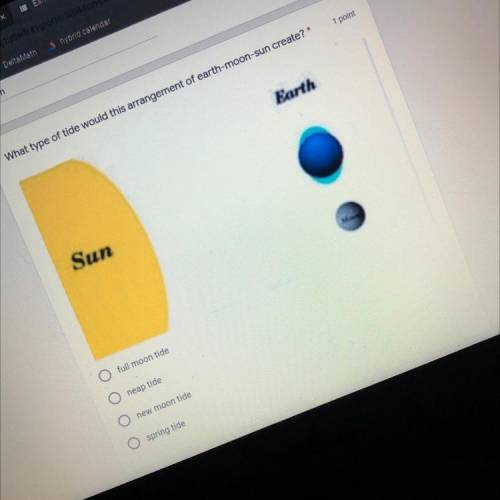What type of tide would this arrangement of earth-moon-sun create?*
O full moon tide
O neap t...

Chemistry, 21.01.2021 17:40 iwannasleep
What type of tide would this arrangement of earth-moon-sun create?*
O full moon tide
O neap tide
O new moon tide
Ospring tide
HURRY!!!


Answers: 3


Another question on Chemistry


Chemistry, 22.06.2019 17:40
Experiment: effect of solution concentration on reaction rate you have learned that as the concentration of reactants increases, there will most likely be a greater number of collisions, and hence increase the rate of a reaction. in this experiment, you will see a demonstration of this, with a twist. there will be three reactions going on in this experiment. objectives determine how solution concentration can affect the rate of a reaction. the first reaction will be a reaction of the iodide ion (i-1) with hydrogen peroxide (h2o2) in an acidic solution. this reaction produces a slightly orange solution. in our experiment, we will add some orange food coloring to make this solution more orange. 2 h+ (aq) + 2 i- (aq) + h2o2 (aq) ⟶ i2 (aq) + 2 h2o (l) the next reaction will be between the iodine and starch i2 + starch ⟶ i2-starch complex (blue-black) so, when starch is added to the iodine solution made from the first reaction, the solution will turn black immediately, so it is difficult to find the rate of reaction. in order to be able to time this reaction, you will slow it down with another reaction. adding ascorbic acid will react with the iodine, reducing the concentration of the iodine available to react with the starch. c6h8o6 (aq) + i2 (aq) ⟶ 2i- (aq) + c6h6o6 (aq) + 2 h+ (aq) when the ascorbic acid is used up, the remaining iodine molecules can react with the starch and form the black color. the more ascorbic acid you add, the slower the reaction to form the iodine-starch complex will be. use your data and observations to complete the assignment. analysis and conclusions submit your data and the answers to these questions in the essay box below. what was your hypothesis? plot your data as drops of ascorbic acid vs. time. as the concentration of ascorbic acid was increased, did the rate of the formation of the iodine-starch complex increase or decrease? explain your answer in terms of the chemical reactions involved. was your hypothesis correct? make a general rule about the effects of concentration of reactants on reaction rates. for practice, the molecular formula for ascorbic acid is c6h8o6, and you used 6 g in this experiment, calculate the molarity of the ascorbic acid. now calculate the concentration in moles per drop (assume 1 ml = 20 drops).
Answers: 3

Chemistry, 23.06.2019 06:40
4786 joules of heat are transferred to a 89.0 gramsample of an unknown material, with an initialtemperature of 23.0°c. what is the specific heat of thematerialif the final temperature is 89.5 °c?
Answers: 1

Chemistry, 23.06.2019 16:00
Be sure to answer all parts. the catalytic destruction of ozone occurs via a two-step mechanism, where x can be any of several species: (1) x + o3 → xo + o2 [slow] (2) xo + o → x + o2 [fast] (a) write the overall reaction. o3 + o → 2 o2 o3 + xo → x + 2 o2 xo + x + o3 + o → xo + x + 2 o2 x + o3 → xo + o2 (b) write the rate law for each step (using k for the rate constant). reaction 1: reaction 2: k[x][o2] k[xo][o2] k[x][o3] k[xo][o3] k[xo][o2] k[x][o] k[x][o2] k[xo][o] (c) x acts as a and xo acts as a catalyst intermediate intermediate catalyst (d) high-flying aircraft release no into the stratosphere, which catalyzes this process. when o3 and no concentrations are 3 ă— 1012 molecule/cm3 and 9.9 ă— 109 molecule/cm3, respectively, what is the rate of o3 depletion? the rate constant k for the rate-determining step is 6 ă— 10â’15 (cm3)2/moleculeâ·s. give your answer in scientific notation. use one significant figure in your answer. ă— 10 molecule/s
Answers: 2
You know the right answer?
Questions

English, 10.10.2019 06:30

Biology, 10.10.2019 06:30

Mathematics, 10.10.2019 06:30


History, 10.10.2019 06:30

Advanced Placement (AP), 10.10.2019 06:30

Geography, 10.10.2019 06:30

Health, 10.10.2019 06:30


Mathematics, 10.10.2019 06:30




Social Studies, 10.10.2019 06:30

Social Studies, 10.10.2019 06:30

Mathematics, 10.10.2019 06:30






